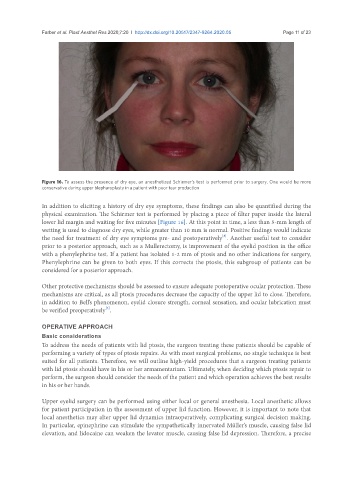Page 210 - Read Online
P. 210
Farber et al. Plast Aesthet Res 2020;7:20 I http://dx.doi.org/10.20517/2347-9264.2020.05 Page 11 of 23
Figure 16. To assess the presence of dry eye, an anesthetized Schirmer’s test is performed prior to surgery. One would be more
conservative during upper blepharoplasty in a patient with poor tear production
In addition to eliciting a history of dry eye symptoms, these findings can also be quantified during the
physical examination. The Schirmer test is performed by placing a piece of filter paper inside the lateral
lower lid margin and waiting for five minutes [Figure 16]. At this point in time, a less than 5-mm length of
wetting is used to diagnose dry eyes, while greater than 10 mm is normal. Positive findings would indicate
[8]
the need for treatment of dry eye symptoms pre- and postoperatively . Another useful test to consider
prior to a posterior approach, such as a Mullerectomy, is improvement of the eyelid position in the office
with a phenylephrine test. If a patient has isolated 1-2 mm of ptosis and no other indications for surgery,
Phenylephrine can be given to both eyes. If this corrects the ptosis, this subgroup of patients can be
considered for a posterior approach.
Other protective mechanisms should be assessed to ensure adequate postoperative ocular protection. These
mechanisms are critical, as all ptosis procedures decrease the capacity of the upper lid to close. Therefore,
in addition to Bell’s phenomenon, eyelid closure strength, corneal sensation, and ocular lubrication must
[3]
be verified preoperatively .
OPERATIVE APPROACH
Basic considerations
To address the needs of patients with lid ptosis, the surgeon treating these patients should be capable of
performing a variety of types of ptosis repairs. As with most surgical problems, no single technique is best
suited for all patients. Therefore, we will outline high-yield procedures that a surgeon treating patients
with lid ptosis should have in his or her armamentarium. Ultimately, when deciding which ptosis repair to
perform, the surgeon should consider the needs of the patient and which operation achieves the best results
in his or her hands.
Upper eyelid surgery can be performed using either local or general anesthesia. Local anesthetic allows
for patient participation in the assessment of upper lid function. However, it is important to note that
local anesthetics may alter upper lid dynamics intraoperatively, complicating surgical decision making.
In particular, epinephrine can stimulate the sympathetically innervated Müller’s muscle, causing false lid
elevation, and lidocaine can weaken the levator muscle, causing false lid depression. Therefore, a precise

